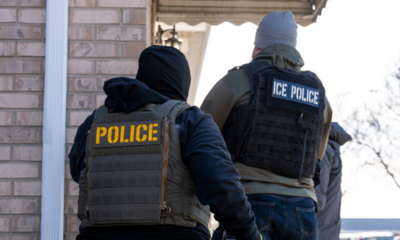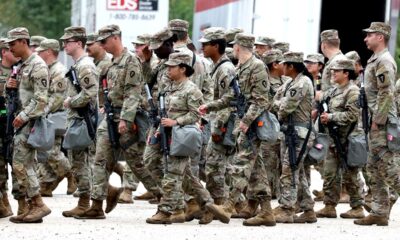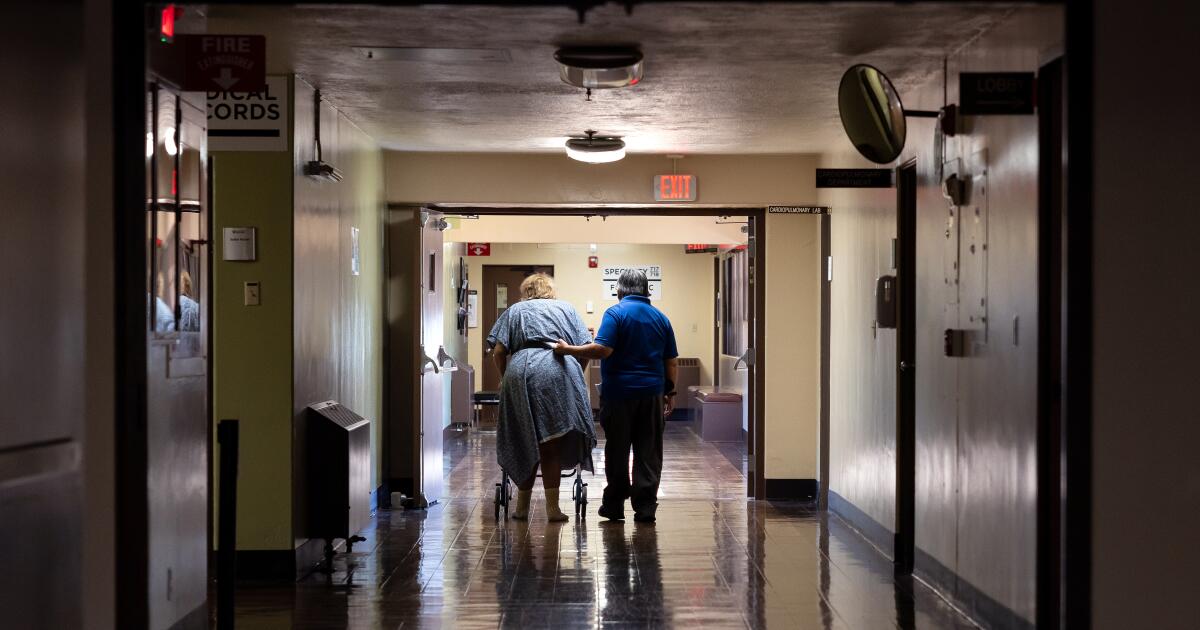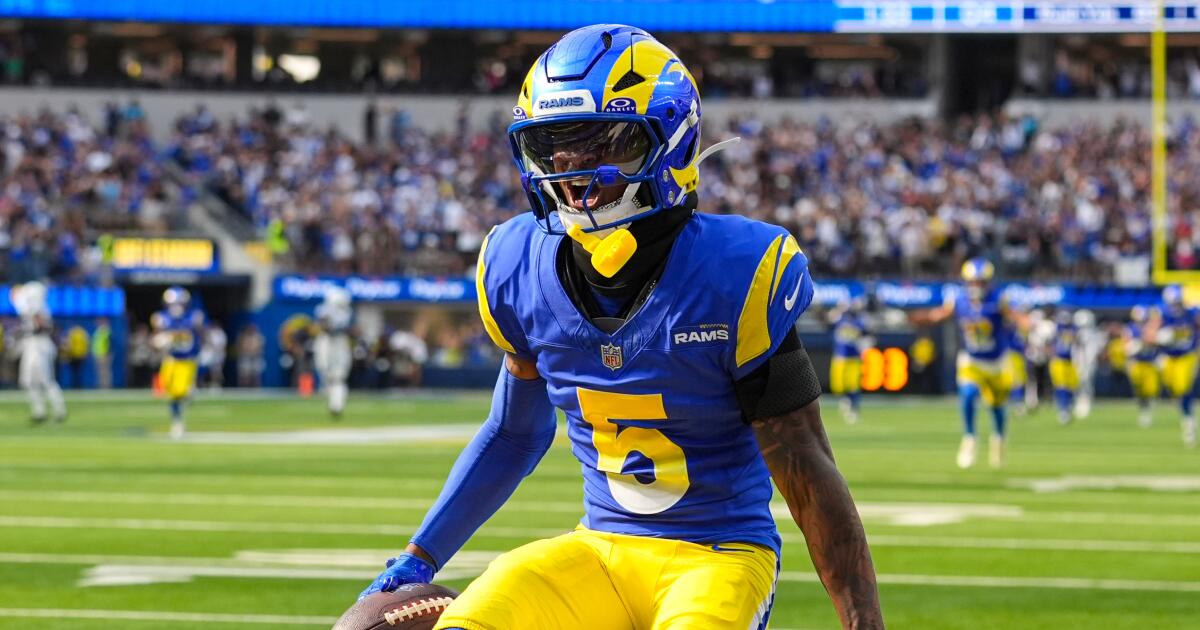West Virginia
Asian American and Latino voters prized in an excruciatingly tight presidential campaign • West Virginia Watch

DURHAM, N.C. — As a weekend morning in late September dips into the afternoon, Annar Parikh finally gets an eligible voter to answer the door.
After Parikh gives a rundown of some of the local candidates in North Carolina’s election, she asks the woman if she plans to vote in the presidential election.
“It’s personal,” the woman says before closing the door.
The 26-year-old marks the house in a voter database for North Carolina Asian Americans Together, a nonpartisan organization that focuses on voter registration in the Asian American community.
“This is typical for our community,” Parikh, a field manager for NCAAT, says while peeling a clementine, recounting how difficult it can be sometimes to reach voters in the swing state.
There are more than 360,000 Asian Americans in North Carolina. Indian Americans are the fastest growing ethnic group in the state, with a population of nearly 110,000.
The voters Parikh is trying to reach are prized by the presidential campaigns. In an election that is virtually a dead heat, Democratic presidential nominee Kamala Harris is working to tap into the two of the fastest-growing voting blocs in the United States — Asian Americans and Latinos, especially in the seven swing states.
Asian Americans have gotten relatively little attention in the presidential campaign and Harris herself has not greatly emphasized her South Asian background — her mother was an Indian immigrant and Harris if elected would be the first president of South Asian descent.
“My challenge is the challenge of making sure I can talk with and listen to as many voters as possible and earn their vote, and I will never assume that anyone in our country should elect a leader based on their gender or their race,” Harris said in a Monday night interview with NBC News, when asked if sexism is a factor in the race.
While Republican nominee Donald Trump has held events with Latino voters, one of his first big appeals to Asian American voters will be Thursday in a Turning Point PAC event with former GOP presidential candidate Vivek Ramaswamy and former Rep. Tulsi Gabbard of Hawaii in Nevada.
Targeting communities
Also Thursday, the Democratic National Committee launched a voting media campaign across the country to engage with Asian American, Native Hawaiian and Pacific Islander communities. The campaign will provide information about polling locations and multilingual advertisements in Florida, Texas and New York.
About 15 million Asian Americans are eligible to vote in this presidential election, a 15% increase in eligible voters from 2020, according to the Pew Research Center.
An estimated 36.2 million Latinos are eligible to vote this year, a 12% increase in eligible voters from 2020, according to the Pew Research Center.
The Harris campaign has launched targeted ads for Asian American voters in the battleground states of Arizona, Georgia, Michigan, North Carolina, Pennsylvania, and Wisconsin that focus on her economic proposals.
The campaign also released an ad specific to the battleground state of Nevada featuring Asian American small business owners. Nevada is a swing state with one of the largest shares of the Asian American population in the country, at 11%. President Joe Biden won the state in 2020 with a little over 33,000 votes.
The Harris campaign has also launched a WhatsApp outreach effort in the Latino community and on Tuesday unveiled an “opportunity agenda for Latino men.”
Grassroot campaigns reflecting Asian American voting blocs have also emerged on behalf of Harris, such as South Asians for Harris, Chinese Americans for Harris, Korean Americans for Harris, Latinas for Harris and Latino Men for Harris.
Getting voters to the polls
On-the-ground efforts like voter registration and voter mobilization can be a huge effort in a tight presidential race.
“The cause of the low rate of voter registration is the same cause of the low level of information around voting, so we want to make sure we’re not just registering people, we’re also talking to them about how the process of voting works, where they can vote, how they can vote early,” said Jack Golub, the North Carolina community engagement program manager for the Hispanic Federation, a group that does civic engagement in the Latino community.
Nationally, the voting registration gap for Latinos — the difference between those eligible to vote who have registered and those who have not registered — is about 13.2 million, which is based on the most recent data from 2022 from UNIDOS, a Latino advocacy organization.
The Trump campaign has largely focused on trying to make inroads with Latino voters through roundtable discussions with leaders as well as a town hall hosted by Univision for undecided Latino voters. Separately, Harris also took part in a Univision town hall with undecided Latino voters.
A Monday poll showed that Harris continues to outperform Trump among Latino voters in the battlegrounds of Arizona, Michigan, Nevada, North Carolina, Pennsylvania and Wisconsin.
When it comes to Asian American voters and Trump, his rhetoric during his first term around the coronavirus and linking it to China could have fueled anti-Asian sentiment among Trump voters, a study shows.
But Steven Cheung, a senior adviser to the Trump campaign, said in a statement to States Newsroom that the former president is an advocate for the Asian American and Pacific Islander community and has “created an environment where diversity, equal opportunity, and prosperity were afforded to everybody.”
“Anyone who says otherwise is disgustingly using the AAPI community to play political games for their own benefit,” Cheung said. “The 2024 campaign is poised to build upon the strength and successes of Asian Americans during President Trump’s first term to propel him to a … second term victory.”
It comes down to policy
With Harris at the top of the Democratic presidential ticket after Biden’s withdrawal last summer, more Asian American voters are planning to support her compared to when Biden was in the race, according to a comprehensive survey by AAPIVote and AAPI Data.
The late September survey also said 66% of Asian American voters said they plan on voting for Harris, compared to 28% of Asian American voters who said they would vote for Trump. About 6% were undecided.
Chintan Patel, the executive director of Indian American Impact, said that while he has noticed an enthusiasm for Harris leading the presidential ticket, it still comes down to policy, specifically the economy, for the South Asian community.
“Yes, the community is excited about the opportunity to elect a South Asian president, there’s no question, but we’re also looking for, what are her plans?” he said.
His organization focuses on electing Indian Americans and has backed Harris.
“One of the things that I think is really resonating with the community is her plans around the economy, creating an opportunity economy, particularly helping small businesses,” Patel said. “Small businesses have been such a vital, important part of mobility for South Asian Americans, particularly the immigrant story, the first generation story, that is how we have seen mobility.”
Harris often talks of her late mother’s roots. But that seems to have little sway in some parts of North Carolina’s South Asian community — a surprise to Eva Eapen, an 18-year-old canvasser for NCAAT.
Eapen, a sophomore at the University of North Carolina at Chapel Hill, said she expected to see more excitement in the South Asian community when Harris picked up the torch for Democrats as the presidential nominee.
“I don’t know if it’s lack of engagement. I don’t know if it’s lack of information. I don’t know if it’s lack of mobilization, but they don’t really care,” she said. “Maybe it’s more policy over nationality as Hindi?”
Several South Asian voters who States Newsroom spoke with in North Carolina made similar remarks. The fact that the Democratic presidential nominee was South Asian didn’t guarantee their vote and they instead expressed concern over the cost of living and the economy.
Ikamjit Gill, 28, said the biggest issues getting him to the polls are inflation and the economy.
“It’s not a big thing for me,” Gill said of Harris’ background.
Gill said he’s a registered Democrat and voted for Biden in 2020, but this year he’s considering voting for Trump. He said he was laid off from his tech job under the Biden administration and got his first job under the Trump administration.
“I’ve been out of a job for a while,” he said. “I just want some change.”
Vishal Ohir, 47, of Wake County, North Carolina, said he was initially leaning toward voting for Trump, but was impressed by Harris during the presidential debate in September. He liked her detailed plans around housing and the economy.
Ohir said he’s still undecided but in the end, he wants a presidential candidate who can tackle the cost of living because “everything has gone up.”
Arvind Balaraman, 53, of Wake County, North Carolina, said he’s frustrated that wages have not kept up with the cost of living. He said he’s not particularly excited there’s a South Asian candidate running for president. He just wants his grocery bill lowered.
“Everything has doubled, tripled,” he said of prices. “You had two different parties in the last two terms and the prices are still going up.”
Balaraman said he’s undecided, but still plans to vote in the presidential election.
GET THE MORNING HEADLINES.

West Virginia
WV lawmakers sign national letter opposing federal preemption over AI regulation

West Virginia
U.S. Sen. Jim Justice of West Virginia agrees to pay nearly $5.2M in overdue personal taxes – WTOP News

CHARLESTON, W.Va. (AP) — U.S. Sen. Jim Justice of West Virginia has agreed to pay nearly $5.2 million in overdue…
CHARLESTON, W.Va. (AP) — U.S. Sen. Jim Justice of West Virginia has agreed to pay nearly $5.2 million in overdue personal taxes, the latest saga for the former billionaire who has been followed by a trail of financial challenges going back well over a decade.
An attorney for Justice and his wife, Cathy, entered into a joint motion for consent judgment with the federal government Monday, the same day that the government filed a lawsuit saying that the couple “have neglected or refused to make full payment” for the income taxes dating to 2009. An attorney for the U.S. Justice Department’s tax division signed off on the agreement.
Justice had a fortune estimated at $1.9 billion last decade by Forbes magazine, which stripped his billionaire title in 2021, when Justice’s worth had dwindled to an estimated $513 million. Earlier this year, Forbes estimated that Justice’s net worth had disintegrated to “less than zero” due to liabilities that far exceeded assets.
A spokesperson for Justice’s office didn’t immediate respond to an email seeking comment Tuesday.
During a briefing with local media in October, Justice asserted that his companies “are complicated and complex” and that his children “are doing a magnificent job” running them. He then repeated past assertions that collection efforts against him were politically motivated, before concluding:. “At the end of the day, I’d say just let it be and see how it all plays out.”
Justice, a former two-term Republican governor who owns dozens of businesses that include coal and agricultural operations, was elected last November to the Senate. He took over the seat vacated by the retiring Joe Manchin, a Democrat who became an independent in 2024 near the end of his second full term.
Justice still has other financial challenges to work out.
The Internal Revenue Service last month filed liens totaling more than $8 million against Justice and his wife on unpaid personal taxes. In September, state tax officials filed $1.4 million in liens against the Justice family’s historic hotel, The Greenbrier, and the resort’s Greenbrier Sporting Club, over unpaid sales taxes.
Last month, a foreclosure auction on several hundred lots owned by the Justice family at a resort community near Beckley was paused. The auction centered on a dispute between the Glade Springs Village Property Owners Association and Justice Holdings over unpaid fees. The state Supreme Court plans to review the case more closely.
In 2021, the IRS filed liens over $1.1 million in unpaid taxes on the Greenbrier Hotel and an additional $80,000 on the resort’s medical clinic. Those debts were paid off later that year.
Justice’s family settled debts last year in a separate case to avoid the Greenbrier Hotel’s foreclosure. The 710-room hotel, which has hosted U.S. presidents, royalty and congressional retreats, had come under threat of being auctioned off on the steps of a Lewisburg courthouse. That was after JPMorgan Chase sold a longstanding loan taken out by Justice to a credit collection company, Beltway Capital, which declared it to be in default.
The state Democratic Party has said efforts to seize the hotel from Justice were “a direct consequence of his own financial incompetence.”
Last year, a union official at the Greenbrier said that Justice’s family was at least $2.4 million behind in payments to an employees’ health insurance fund, putting workers’ coverage at risk. In 2023, dozens of properties owned by the Justice family in three counties were auctioned as payment for delinquent real estate taxes. Others have sought to recoup millions in fines for environmental issues and unsafe working conditions at his company’s coal mines.
Justice bought The Greenbrier resort out of bankruptcy in 2009 for $20.1 million. The sporting club is a private equity club and residential community on the property that opened in 2000.
The resort in White Sulphur Springs that dates to 1778 also has a casino, spa and dozens of amenities and employs around 2,000 workers. The resort held a PGA Tour golf tournament from 2010 until 2019 and has welcomed NFL teams for training camp and practices. A once-secret 112,000-square-foot (10,080-square-meter) underground bunker built for Congress at the Greenbrier in case of nuclear attack during the Cold War now hosts tours.
Copyright
© 2025 The Associated Press. All rights reserved. This material may not be published, broadcast, written or redistributed.
West Virginia
Thousands of hunters venture into W.Va. woods on first day of buck gun season

MASON COUNTY, W.Va. (WCHS) — Thousands of hunters hit the West Virginia woods on a foggy Monday morning as the two-week buck gun season got underway.
According to 2022 numbers, hunting is an $850 million business in West Virginia and buck hunting is its big game.
State officials predict a downtick in bucks taken between now and the Dec. 7 end-of-season due in part to abundant acorns that make it less likely deer will be spotted in the open.
Portions of the Mid-Ohio Valley have seen from herd losses due to deaths from epizootic hemorrhagic disease.
Successful hunt or not, it’s a tradition in the Mountain State.
“It’s just a family tradition. We’ve been doing it since we were little,” Wyoming County hunter Steven Lovins said. “A tradition for some where the outdoors has generated some of the best memories of a lifetime.”
There’s still enough hunting interest in West Virginia to support about 7,400 jobs.
The weather is a factor, but typically most of the deer are killed during the first three days of the buck gun season.
To share memories of your hunt, visit the Chime In portion of our webpage.
-
Business1 week ago
Fire survivors can use this new portal to rebuild faster and save money
-

 World1 week ago
World1 week agoFrance and Germany support simplification push for digital rules
-

 News1 week ago
News1 week agoCourt documents shed light on Indiana shooting that sparked stand-your-ground debate
-

 World1 week ago
World1 week agoSinclair Snaps Up 8% Stake in Scripps in Advance of Potential Merger
-

 Science5 days ago
Science5 days agoWashington state resident dies of new H5N5 form of bird flu
-

 World1 week ago
World1 week agoCalls for answers grow over Canada’s interrogation of Israel critic
-

 Politics1 week ago
Politics1 week agoDuckworth fires staffer who claimed to be attorney for detained illegal immigrant with criminal history
-

 Technology1 week ago
Technology1 week agoFake flight cancellation texts target travelers





















